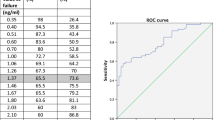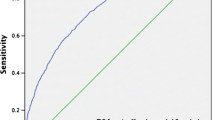Abstract
Purpose
To determine when 18F-choline PET/CT can truly identify local recurrence of prostate cancer.
Methods
1031 patients from 3 European centers underwent 18F-choline PET/CT (FCH PET/CT) for recurrent disease; 131 subjects (12.7%) showed a positive FCH uptake in the prostatic gland or prostatic fossa. Median age was 72 years (range 48–87 years), and the median PSA level at the time of FCH PET/CT scan was 4.41 ng/mL (0.22–18.13 ng/mL). 45 patients (34.4%) had a Gleason score (GS) >7, and the residual subjects had a GS ≤7. The assessment of true or false-positive FCH PET/CT findings was made by magnetic resonance imaging (n = 34) and/or biopsy in 75/131 cases. A χ 2 test and a Z Kolmogorov–Smirnov test were used to assess the correlation between clinical variables (age, PSA, GS, type of therapy) and FCH PET/CT findings.
Results
FCH PET/CT resulted truly positive (TP) for recurrent disease in the prostatic gland/fossa in 59/75 patients (79%) and falsely positive (FP) in 16 subjects (21%). The median value of PSA at the time of FCH PET/CT scan was higher in TP as compared to FP, although not statistically significant (4.76 vs. 3.04 ng/mL p > 0.05). Similarly, median age, GS categories, and the type of therapy were similar between the two groups (p > 0.05). However, when matching GS categories and PSA values, we found that the number of patients with TP findings were higher in the case of a PSA >2 ng/mL, independently from the GS (ranging between 74% and 92%). Conversely, FP rate ranged between 50% and 65% in patients with a PSA ≤2 ng/mL, especially in the case of GS ≤7, whereas FP was around 25% in those with a GS >7 and PSA >2 ng/mL.
Conclusions
FCH PET/CT has a limited role in evaluation of prostatic gland/fossa recurrence, due to the physiological biodistribution of the radiopharmaceutical agent. However, in 70–90% of patients with a PSA >2 ng/mL, independently from GS, a focal FCH uptake is compatible with a true local recurrence.


Similar content being viewed by others
References
Paparo F, Piccardo A, Bacigalupo L, et al. (2015) Value of bimodal 18F-choline-PET/MRI and trimodal 18F-choline-PET/MRI/TRUS for the assessment of prostate cancer recurrence after radiation therapy and radical prostatectomy. Abdom Imaging 40:1772–1787.
Pfitzenmaier J, Pahernik S, Tremmel T, et al. (2008) Positive surgical margins after radical prostatectomy: do they have an impact on biochemical or clinical progression? BJU Int 102:1413–1418
Martino P, Scattoni V, Galosi AB, et al. (2011) Role of imaging and biopsy to assess local recurrence after definitive treatment for prostate carcinoma (surgery, radiotherapy, cryotherapy, HIFU). World J Urol 29:595–605
Sella T, Schwartz LH, Swindle PW, et al. (2004) Suspected local recurrence after radical prostatectomy: endorectal coil MR imaging. Radiology 231:379–385
De Visschere PJ, Vargas HA, Ost P, et al. (2013) Imaging treated prostate cancer. Abdom Imaging 38:1431–1446
Martino P, Scattoni V, Galosi AB, et al. (2011) Role of imaging and biopsy to assess local recurrence after definitive treatment for prostate carcinoma (surgery, radiotherapy, cryotherapy, HIFU). World J Urol 29:595–605
Kirkham AP, Emberton M, Allen C (2006) How good is MRI at detecting and characterizing cancer within the prostate? Eur Urol 50:1163–1175
Prando A, Kurhanewicz J, Borges AP, et al. (2005) Prostatic biopsy directed with endorectal MR spectroscopic imaging findings in patients with elevated prostate specific antigen levels and prior negative biopsy findings: early experience. Radiology 236:903–910
Sciarra A, Panebianco V, Salciccia S, et al. (2008) Role of dynamic contrast-enhanced magnetic resonance (MR) imaging and proton MR spectroscopic imaging in the detection of local recurrence after radical prostatectomy for prostate cancer. Eur Urol 54:589–600
Sella T, Schwartz LH, Swindle PW, et al. (2004) Suspected local recurrence after radical prostatectomy: endorectal coil MR imaging. Radiology 231:379–385
Cirillo S, Petracchini M, Scotti L, et al. (2009) Endorectal magnetic resonance imaging at 1.5 T to assess local recurrence following radical prostatectomy using T2- weighted and contrast enhanced imaging. Eur Radiol 19:761–769
De Visschere PJ, De Meerleer GO, Fütterer JJ, et al. (2010) Role of MRI in follow-up after focal therapy for prostate carcinoma. AJR Am J Roentgenol 194:1427–1433
Yakar D, Hambrock T, Huisman H, et al. (2010) Feasibility of 3 T dynamic contrast enhanced magnetic resonance-guided biopsy in localizing local recurrence of prostate cancer after external beam radiation therapy. Invest Radiol 45:121–125
Coakley FV, The HS, Qayyum A, et al. (2004) Endorectal MR imaging and MR spectroscopic imaging for locally recurrent prostate cancer after external beam radiation therapy: preliminary experience. Radiology 233:441–448
Haider MA, Chung P, Sweet J, et al. (2008) Dynamic contrast-enhanced magnetic resonance imaging for localization of recurrent prostate cancer after external beam radiotherapy. Int J Radiat Oncol Biol Phys 70:425–430
Rouviere O, Valette O, Grivolat S, et al. (2004) Recurrent prostate cancer after external beam radiotherapy: value of contrast-enhanced dynamic MRI in localizing intraprostatic tumor—correlation with biopsy findings. Urology 63:922–927
Westphalen AC, Coakley FV, Roach M 3rd, et al. (2010) Locally recurrent prostate cancer after external beam radiation therapy: diagnostic performance of 1.5-T endorectal MR imaging and MR spectroscopic imaging for detection. Radiology 256:485–492
Evangelista L, Zattoni F, Guttilla A, et al. (2013) Choline PET or PET/CT and biochemical relapse of prostate cancer. a systematic review and meta-analysis. Clin Nucl Med 38:305–314
Panebianco V, Sciarra A, Lisi D, et al. (2012) Prostate cancer: 1HMRS-DCEMR at 3 T versus [(18)F]choline PET/CT in the detection of local prostate cancer recurrence in men with biochemical progression after radical retropubic prostatectomy (RRP). Eur J Radiol 81:700–708
D’Angelillo RM, Sciuto R, Ramella S, et al. (2014) 18F-choline positron emission tomography/computed tomography driven high-dose salvage radiation therapy in patients with biochemical progression after radical prostatectomy: feasibility study in 60 patients. Int J Radiat Oncol Biol Phys 90:296–302
Piccardo A, Paparo F, Picazzo R, et al. (2014) Fused 18F-choline-PET/MRI to evaluate prostate cancer relapse in patients showing biochemical recurrence after EBRT: preliminary results. BioMed Res Int 2014:1–9
Beheshti M, Haim S, Zakavi R, et al. (2013) Impact of 18F-choline PET/CT in prostate cancer patients with biochemical recurrence: influence of androgen deprivation therapy and correlation with PSA kinetics. J Nucl Med 54:833–840
Henninger B, Vesco P, Putzer D, et al. (2012) [18F]choline positron emission tomography in prostate cancer patients with biochemical recurrence after radical prostatectomy: influence of antiandrogen therapy—a preliminary study. Nucl Med Commun 33:889–894
Schillaci O, Calabria F, Tavolozza M, et al. (2012) Influence of PSA, PSA velocity and PSA doubling time on contrast-enhanced 18F-choline PET/CT detection rate in patients with rising PSA after radical prostatectomy. Eur J Nucl Med Mol Imaging 39:589–596
Husarik DB, Miralbell R, Dubs M, et al. (2008) Evaluation of [18F]-choline PET/CT for staging and restaging of prostate cancer. Eur J Nucl Med Mol Imaging 35:253–263
Pelosi E, Arena V, Skanjeti A, et al. (2008) Role of whole-body 18F-choline PET/CT in disease detection in patients with biochemical relapse after radical treatment for prostate cancer. Radiol Med 113:895–904
Vees H, Buchegger F, Albrecht S, et al. (2007) 18F-choline and/or 11C-acetate positron emission tomography: detection of residual or progressive subclinical disease at very low prostate-specific antigen values (< 1 ng/mL) after radical prostatectomy. BJU Int 99:1415–1420
Picchio M, Messa C, Landoni C, et al. (2003) Value of (11C)choline positron emission tomography for re-staging prostate cancer: a comparison with (18F)fluorodeoxyglucose-positron emission tomography. J Urol 169:1337–1340
Richter JA, Rodriguez M, Rioja J, et al. (2010) Dual tracer 11C-choline and FDG-PET in the diagnosis of biochemical prostate cancer relapse after radical treatment. Mol Imaging Biol 12:210–217
Cimitan M, Bortolus R, Morassut S, et al. (2006) [18F]fluorocholine PET/CT imaging for the detection of recurrent prostate cancer at PSA relapse: experience in 100 consecutive patients. Eur J Nucl Med Mol Imaging 33:1387–1398
Chondrogiannis S, Marzola MC, Ferretti A, et al. (2014) Is the detection rate of 18F-choline PET/CT influenced by androgen-deprivation therapy? Eur J Nucl Med Mol Imaging 41:1293–1300
Chondrogiannis S, Marzola MC, Grassetto G, et al. (2014) New acquisition protocol of 18F-choline PET/CT in prostate cancer patients: review of the literature about methodology and proposal of standardization. Biomed Res Int. 2014:215650
Alonso O, Dos Santos G, Savio E, et al. (2015) False-positive results of 68ga-dotatate and 11c-choline PET/CT in patients with hormone-resistant prostate cancer at biochemical recurrence are related to inflamed lesions. Mol Imaging Radionucl Ther 24:37
Wyss MT, Weber B, Honer M, et al. (2004) 18F-choline in experimental soft tissue infection assessed with autoradiography and high-resolution PET. Eur J Nucl Med Mol Imaging 31:312–316
Lahmer G, Lotter M, Kreppner S, et al. (2013) Protocol-based image-guided salvage brachytherapy. Early results in patients with local failure of prostate cancer after radiation therapy. Strahlenther Onkol 189:668–674
Heiderenreich A, Thüer D, Pfister D (2010) Salvage radical prostatectomy. Panminerva Med 52:231–237
Gleave ME, La Bianca SE, Goldenberg SL, et al. (2000) Long-term neoadjuvant hormone therapy prior to radical prostatectomy: evaluation of risk for biochemical recurrence at 5-year follow-up. Urology 56:289–294
Shelley MD, Kumar S, Wilt T, et al. (2009) A systematic review and meta-analysis of randomized trials of neo-adjuvant hormone therapy for localized and locally advanced prostate carcinoma. Cancer Treat Rev 35:9–17
Breeuwsma AJ, Pruim YJ, Alphons Y, et al. (2010) Detection of local, regional, and distant recurrence in patients with Psa relapse after external-beam radiotherapy using 11C-choline positron emission tomography. Int J Radiat Oncol Biol Phys 77:160–164
Alongi F, Liardo RLE, Iftode C, et al. (2014) 11C choline PET guided salvage radiotherapy with volumetric modulation arc therapy and hypofractionation for recurrent prostate cancer after HIFU failure: preliminary results of tolerability and acute toxicity. Technol Cancer Res Treat 13:395–401
Hodolič M, Maffione AM, Fettich J, et al. (2013) Metastatic prostate cancer proven by 18F-FCH PET/CT staging scan in patient with normal PSA but high PSA doubling time. Clin Nucl Med 38:739–740
Evangelista L, Cervino AR, Guttilla A, et al. (2015) 18F-fluorometilcholine or 18F-fluoroethylcholine PET for prostate cancer imaging: which is better? A Literature Revision. Nucl Med Biol 42:340–348
Acknowledgment
The author would like to thank Christina Drace for her help in the language revision for this manuscript.
Conflict of interest
None.
Author information
Authors and Affiliations
Corresponding author
Additional information
CME activity
This article has been selected as the CME activity for the current month. Please visit https://ce.mayo.edu/node/6231 and follow the instructions to complete this CME activity.
Rights and permissions
About this article
Cite this article
Evangelista, L., Cimitan, M., Hodolič, M. et al. The ability of 18F-choline PET/CT to identify local recurrence of prostate cancer. Abdom Imaging 40, 3230–3237 (2015). https://doi.org/10.1007/s00261-015-0547-0
Published:
Issue Date:
DOI: https://doi.org/10.1007/s00261-015-0547-0




